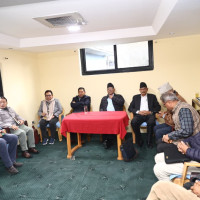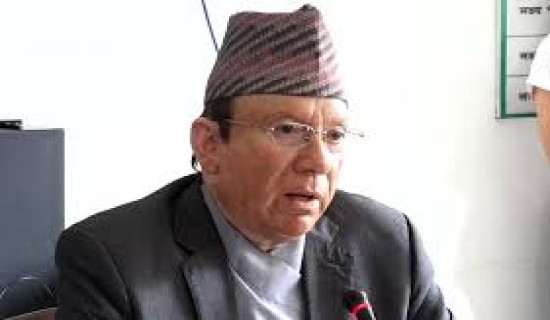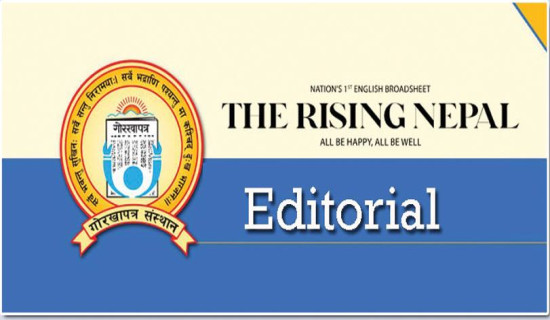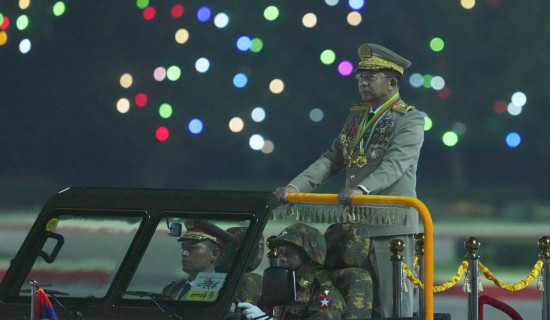- Sunday, 2 November 2025
Swayambhu enchants visitors with peace and strength
By Sushma Maharjan,Kathmandu, Feb. 7: Every morning before sunrise, 52-year-old Nhuchhe Shrestha begins his familiar journey to Swayambhu. Leaving his home in Sano Bharyang, he walks briskly through the quiet streets, reaching Bhagwan Pau.
“I can’t start my day without coming here,” he says. For him, visiting Swayambhu is both an act of paying homage and maintaining fitness, as reaching the top requires climbing hundreds of uphill steps.
Perched atop a hill, Swayambhu is one of Nepal’s oldest religious sites, dating back more than 1,500 years. According to a legend, the Kathmandu Valley was once a vast lake. When Bodhisattva Manjushree drained the water by cutting the gorge at Chovar with a single stroke of his sword, a lotus settled on this very hill and its eternal flame transformed into the Swayambhu stupa.
Like Shrestha, many nearby locals visit Swayambhu daily. On special occasions like Buddha Purnima, Saraswati Puja and Gunla (a sacred month-long festival celebrated by the Newar community), the site is flooded with devotees from nearby cities.
Sarita Gurung, a local from Sanepa, is one of those visitors. She lost her husband three years ago. Overwhelmed by grief, she turned to faith for solace. “I did not know how to live without him,” she recalls. “But coming here, lighting a lamp for his soul provides me peace and strength. This place is not just a temple, it’s where my prayers find a home.”
Beyond its religious significance, Swayambhu is also a UNESCO World Heritage Site. As one ascends from Bhagwan Pau, one passes three gigantic Buddha statues, seated in deep meditation.
Along the way, one can observe monkeys swinging from prayer flags, grooming each other and sometimes even snatching small bags and food from pilgrims, a playful yet mischievous presence that earned Swayambhu its nickname, the ‘Monkey Temple.’
In the early morning, the stairs remain quiet and mostly empty, while the open spaces become ideal for exercise and relaxation. However, as the day progresses, souvenir and handicraft stalls line both sides of the path, offering visitors a glimpse into Nepal’s rich artistic traditions.
The climb is dotted with chaityas and shrines. Before reaching the stupa, visitors encounter a massive Vajra (thunderbolt scepter), a symbolic representation of indestructible spiritual power in Vajrayana Buddhism. At the top, people can circumambulate the white stupa in a clockwise direction. The dome of the stupa represents the world, while the all-seeing eyes of Buddha gaze in all four directions, symbolising wisdom and awareness.
Positioned at the four cardinal points are four Buddhas attached to the dome and between them stand four Tara goddesses. And finally, the stupa is completed with a thirteen-tiered golden spire.
Furthermore, many people prefer to circumambulate around Swayambhu at the base instead of climbing the inclined stone steps. This path, known as the Swayambhu Parikrama Marga, encircles the entire hill and is considered a sacred way to pay respect to the stupa.
Swayambhu reflects Nepal’s deep-rooted religious harmony. The site is home to Buddhist monasteries (Bihars) Hindu shrines, and temples dedicated to goddesses like Harati Mata and Saraswati.
More than just a religious site, Swayambhu offers breathtaking panoramic views of the Kathmandu Valley. From its elevated perch, visitors can witness the sprawling cityscape, where ancient temples blend with modern buildings, a reflection of Nepal’s evolving identity. It is the place where the chaos of the city fades, replaced by the echoes of prayer.









-original-thumb.jpg)







